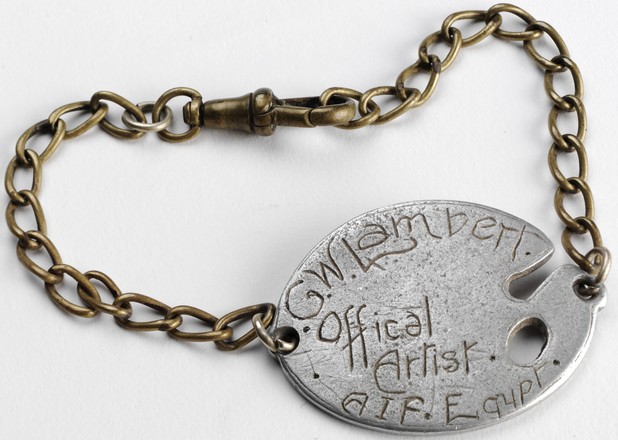
WWI identity disc in the shape of an artist’s palette on chain inscribed ‘G.W. Lambert, Official Artist A.I.F, Egypt’
Metal R 344/1 Presented by Maurice Lambert, 1964

Metal R 344/1 Presented by Maurice Lambert, 1964
Towards the end of 1923 the Australian War Memorial had provided Lambert with rooms rent-free at the Prince of Wales Military Hospital, Randwick, as a studio to complete the war paintings that had been commissioned from him. He slept on a small bed in this complex, which included an area for a painting studio, a sculpture studio and a kitchen. This studio enabled Lambert to take up sculpture seriously, by giving him the space he needed.
National Gallery of Australia
Lambert's first ambition, arising from the time he spent on his great-uncle's property in New South Wales, was to paint the Australian landscape.
Jim Davidson, reCollections, National Museum of Australia, 2007
From his first journey to Palestine and the Sinai in 1918 through to the Australian Historical Mission to Gallipoli in 1919, Lambert produced 99 small panel paintings, and hundreds of drawings and sketches. These small panel paintings, which the official historian Charles Bean described as “brilliant little flashes, vivid with life”, give us an artist’s interpretation of the settings, atmosphere, and detailed topography of battle-sites from ANZAC Cove and the Nek to Romani, Beersheba, and Barada Gorge.
It was Palestine that became the site of Lambert's greatest landscapes — not least because its harshness amplified the sun-struck tonalities he had known in Australia. As Andrew Motion puts it, Palestine 'shook George into originality'. His 'first loyalties were to what actually confronted him', rather than to 'artistic traditions he had worked so hard to assimilate'.
Jim Davidson, reCollections, National Museum of Australia, 2007
Best remembered for his portraits and figure compositions and for his work as an official war artist during World War I, Lambert initially established himself as an illustrator for periodicals such as 'The Bulletin' and 'Australian Magazine'.
George Washington Lambert won the Archibald Prize in 1927 for Mrs Murdoch, being a portrait of journalist Keith Murdoch’s mother Annie.
Born in 1873 in St Petersburg, some months after his American father died, Lambert was taken first to Germany and then to London by his English mother. When Lambert was 10 they migrated to Australia. Later, the longest phase of his career would be spent in England, when he returned there in 1902 after two years in Paris. There was also a significant period of three or four years as a war artist in the Middle East. Although Lambert spent his last nine years based in Sydney, dying there in 1930, the greater part of his productive period was spent abroad.
Jim Davidson, reCollections, National Museum of Australia, 2007
Lambert, who was a very keen boxer in his youth, depicts his interest and knowledge of the subject in The Pugilists, 1910.